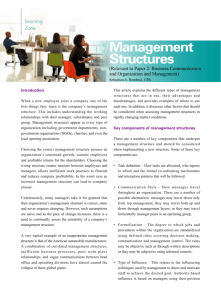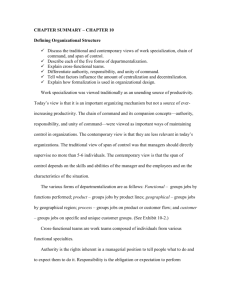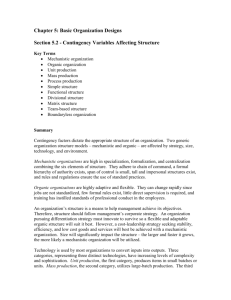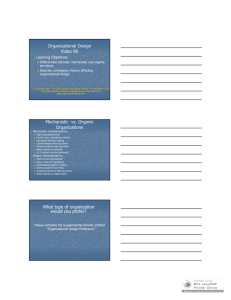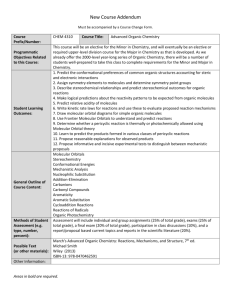Designing a Proper Organizational Chart for a Project
advertisement
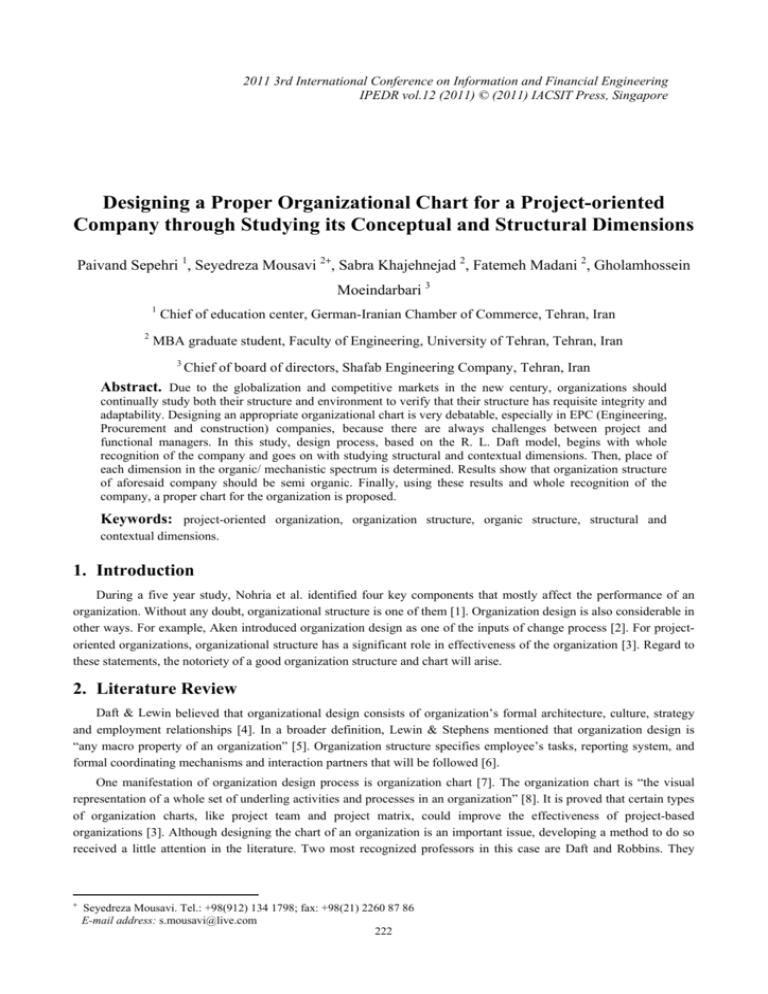
2011 3rd International Conference on Information and Financial Engineering IPEDR vol.12 (2011) © (2011) IACSIT Press, Singapore Designing a Proper Organizational Chart for a Project-oriented Company through Studying its Conceptual and Structural Dimensions Paivand Sepehri 1, Seyedreza Mousavi 2+, Sabra Khajehnejad 2, Fatemeh Madani 2, Gholamhossein Moeindarbari 3 1 2 Chief of education center, German-Iranian Chamber of Commerce, Tehran, Iran MBA graduate student, Faculty of Engineering, University of Tehran, Tehran, Iran 3 Chief of board of directors, Shafab Engineering Company, Tehran, Iran Abstract. Due to the globalization and competitive markets in the new century, organizations should continually study both their structure and environment to verify that their structure has requisite integrity and adaptability. Designing an appropriate organizational chart is very debatable, especially in EPC (Engineering, Procurement and construction) companies, because there are always challenges between project and functional managers. In this study, design process, based on the R. L. Daft model, begins with whole recognition of the company and goes on with studying structural and contextual dimensions. Then, place of each dimension in the organic/ mechanistic spectrum is determined. Results show that organization structure of aforesaid company should be semi organic. Finally, using these results and whole recognition of the company, a proper chart for the organization is proposed. Keywords: project-oriented organization, organization structure, organic structure, structural and contextual dimensions. 1. Introduction During a five year study, Nohria et al. identified four key components that mostly affect the performance of an organization. Without any doubt, organizational structure is one of them [1]. Organization design is also considerable in other ways. For example, Aken introduced organization design as one of the inputs of change process [2]. For projectoriented organizations, organizational structure has a significant role in effectiveness of the organization [3]. Regard to these statements, the notoriety of a good organization structure and chart will arise. 2. Literature Review Daft & Lewin believed that organizational design consists of organization’s formal architecture, culture, strategy and employment relationships [4]. In a broader definition, Lewin & Stephens mentioned that organization design is “any macro property of an organization” [5]. Organization structure specifies employee’s tasks, reporting system, and formal coordinating mechanisms and interaction partners that will be followed [6]. One manifestation of organization design process is organization chart [7]. The organization chart is “the visual representation of a whole set of underling activities and processes in an organization” [8]. It is proved that certain types of organization charts, like project team and project matrix, could improve the effectiveness of project-based organizations [3]. Although designing the chart of an organization is an important issue, developing a method to do so received a little attention in the literature. Two most recognized professors in this case are Daft and Robbins. They + Seyedreza Mousavi. Tel.: +98(912) 134 1798; fax: +98(21) 2260 87 86 E-mail address: s.mousavi@live.com 222 proposed that for developing an organization structure (and organization chart), one should study organizational dimensions [6,8]. There are two types of organizational dimensions: structural and contextual. Structural dimensions describe the internal characteristics of an organization that enable comparison of organizations. Contextual dimensions characterize the whole organization, including its size, technology, culture, environment, and strategy. They describe the organizational settings that influence and shape the structural dimensions [8]. Chandler, studying histories of about 100 American’s largest industrial enterprises, concluded that the structure of an organization follows its strategy. He found that a changing economic environment leads companies to develop new strategies, which in turn necessitates new organizational structure [9]. Another contextual dimension of organization structure is technology. Studying the relationship between technology and structure of an organization, Perrow assumes that: “the type of technology determines an organization’s most effective structure and success in the market” [10]. As Perrow stated, the type of technology which the organization uses affects the structural dimensions of organization like formalization, centralization, and span of control [10]. The effect of environment on organizational structure is best reflected in contingency theory. This theory is based on the assumption that all organizations are open systems that interact with their environments. So, the environment of the organization could affect its structure [11]. In terms of culture, literature often refers to a typology that has been suggested by Burns and Stalker who distinguish between mechanistic and organic organizations. Both terms – mechanistic and organic – describe organizational structure as well as organizational culture. Both organic and mechanistic cultures necessitate different kinds of organizational structure. This indicates that organization culture has effects on organization structure [12]. Six primary dimensions of organizational structure are: ‘specialization, standardization, formalization, centralization, configuration, and flexibility’ [13]. Each dimension in this context is used to determine structural dimension of an organization. As, mentioned before, one manifestation of organization design process is organization chart. In this research we would like to design a proper organizational chart for one of the most reputable EPC contractors in the fields of Water and Waste Water Industry in Iran (Shafab Co.). Due to its engineering, procurement, and construction activities, Shafab is a project-oriented company. With regard to previous researches, organization structure influences the effectiveness of project-oriented organizations [3,14]. Thus, the next question in this area is the process by which one can do the organizing process. Using a case study, we followed a process by which we developed a new organization chart for Shafab Co. 3. Methodology The method which is applied here is based on Richard L. Daft model [15]. Methodology is accomplished in three important phases: 1) Attaining overall information about the company should be the first step. For this purpose, some questionnaires and interviews with all personnel are used. The main subjects of them are about overall view of the organization, its strategic framework, internal specifications of the company, and analysis of status qua of the company. 2) Second, the structural and contextual dimensions are studied. The main purpose of this phase is to place each dimension in the organic/ mechanistic range. As a result, in order to determine the degree of organic/ mechanistic of the company, measurements are scaled to numbers between 0-10. Therefore, the degree of organic/ mechanistic of the company will be deduced from the average of scores. On the subject of structural dimensions (formalization, complexity, and centralization), questionnaires of the Robbin’s book were used [6]. For each of the contextual dimensions, the best applicable approaches were used through questionnaires and interviews. Here, models and methods in each dimension are mentioned briefly: • Strategy: the strategy of the organization would be appointed by Miles & Snow theory [16]. Questionnaires and interviews were accomplished to conclude main strategic approach of the company. • Lifecycle: organizations in their lifecycles experience four stages: Entrepreneurial stage, Collectivity stage, Formalization stage, and elaboration stage. For each of the stages of organization lifecycle, 8 questions were asked from the managers of the organization. 223 • Technology: in the term of technology, Perrow’s model is used [10]. This model scans the framework of the company from two perspectives: work variety and work analyzability. These dimensions result in four classifications of company’s technology which are: Craft, Routine, Non-routine and Engineering. For each dimension, 3 questions were asked from the mangers. • Environment: on the basis of Robert Duncan model, two dimensions of environment were evaluated [17]. For evaluating complexity and change in the organization environment, questionnaire and interviews were accomplished. • Culture: the model which is used here is Organizational Culture Assessment Instrument (OCAI). In this model, six key dimensions of organizational culture are assessed in a very complete questionnaire. Finally, the place of the organizational culture between four types of the cultures (Clan, Adhocracy, Market and Hierarchy) can be defined [18]. 3) Third, the characteristic of the structure is found out. Consequently, the fitting organizational chart by considering all aspects of the organization was designed. 4. Results Here, the main strategic framework of the organization is explained briefly: “Becoming one of the international powerful and successful EPC –EC- E, P or C contractors as it always possesses new and up-to-date technical knowhow’’ is the vision and “Making profit by performing respective projects with minimum cost, optimum time, and best quality.” is the mission of the company. The main goal of the company in its present situation is developing the company's market at domestic and abroad and expanding its services. To evaluate the range of complexity, formalization, and centralization in the company, each relevant question is scored between1-5. It should be noticed that the average of the question scores of each dimension is the measure and each dimension is assigned the number between0-10 to characterize the organic/ mechanistic degree of the company. The average result of complexity dimension is calculated 18.29. The minimum and maximum possible values for the questionnaire are 55 and 22. It is obvious that more degree of complexity leads to more organic structure. Thus, the degree of the complexity in the 0-10 range is 4. The average degree of the formalization in the company is 28.86. The minimum and maximum values of possible answers are 11 and 55. Since the low level of formalization means more organic structure, this degree is 4 in the scale of 0-10. The average value of centralization is computed 32.17. Minimum and maximum possible values are 11 and 55. Since more centralized company is more dynamic, the degree of centralization in organic/ mechanic spectrum was assigned 5. Therefore, the organic/ mechanistic degree is assigned 4.34 as far as structural dimensions are considered. One of the important steps of organization design is identifying organization’s strategy. After specifying the strategic framework of the company, the organization's strategic approach is identified according to the Miles and Snow model. It seems that the type of organization’s strategy is “analyzer” since the uncertainty of environment is moderate and also, the organization seeks to minimize risk and maximize the opportunity to make profit. The size of the organization is to some extent small since it has about 64 employees. It, however, intends to expand. The answers of questions about evaluating the lifecycle stage of the company show that the first stage has maximum measurement. But, the lifetime of the company, the number of employees, the annual turnover rate, and its background do not conform to this point. It seems that there is a bias in the answers that may be ignored by multiplying coefficients for calculating 2th and 3th stages which they are 0.6 for 2th stage and 0.8 for the 3th stage. The results show that the company is in the beginning of 3th stage or at the end of the 2th stage in its lifecycle. It, nevertheless, has some of the crisis of the first and second stages. But, the crisis of moving from the second to third stage is major, such as the necessity of more formalization and delegation. The high rate of employees' turnover confirms this point. The minimum and maximum range for technology aspect is 3 and 15. The result showed that the average score of job variety is 9 and the average score of job analyzability is 10 which stated that the company belongs to the group of companies with engineering technology. The engineering technology characterizes by many exceptions and its depth of comprehension. Standard and accepted methods are available to provide solutions to problems. But, because the variety is equal to average, it shows that the technology is to some extent similar to the Routine technology. The reason can be justified since some works like tenders have a routine process. Anyway, the work is mostly analyzable, because most of the people can use some procedures in their work. In the respect of organic/ mechanistic structure, it can be stated that the organizations with routine technology need higher degree of mechanistic and organizations with non-routine processes need higher 224 degree of organic structure. Engineering and craft technology need moderate degree of organic/ mechanic structure. But Engineering organizations need more mechanistic structure because the most of the processes are usually defined. The environment is assessed from two aspects which are environment complexity and change. The possible minimum, maximum values for complexity and change are 10, 55, and 6, 30. The average values are 37.5 and 16.6. Thus, the complexity of the mentioned company's environment is mostly higher than the average. The changeability is, however, less than average. Consequently, the mentioned company is confronted with the mostly complex and unchangeable environment. It means that many different factors influence its external environment, but these factors do not change rapidly. In ranging two dimensions between 0- 10, the result calculated 6 and 4, so its average degree is 5. Moderate organic structure is suitable for the mentioned organization to be able to face its environment. The result of culture questionnaire clearly shows that the “market culture” is dominant here since the score of this culture is about 45 which is about twice as much as other cultures' scores. The generic strategy of this culture is “analyzer” and the scanning approach is analytical. This result confirms company’s strategic approach. Furthermore, leadership in this type of culture is decisive and achievement-oriented. Dominant attributes are competitiveness and goal achievement. Strategic emphasis of this culture is on the competitive advantages and market superiority. This type of the culture is market-based. This culture necessitates the semi organic structure, fairly more mechanistic. Now, the final degree of the organic/ mechanistic structure can be determined since the different dimensions of the organization were studied. The average degree of organic/ mechanistic degree will be obtained 4.94 as far as structural dimensions, technology, and environment are considered. The culture and life cycle analyses show that the organization should have a moderate degree of organic/ mechanistic structure. However, they emphasize on the mechanistic aspect more. The strategic approach of the organization also verifies that the organization should have an average degree of organic/ mechanistic structure (see Fig. 1). 4.94 Mechanistic Organic 0 1 2 3 6 7 5 Fig. 1: organic/ mechanistic spectrum 4 8 9 10 5. Conclusion The overall knowledge about organization is acquired through studying the organization's status qua, particularly its structural problems, and structural and contextual dimensions, which are helpful in designing an appropriate chart. The recommended chart is shown in Fig. 2. It has semi organic structure, not too tall or too flat, and designed on the basis of organizational needs. In order to meet the customer's needs, the organization should have greater speed of communication between departments, which necessitates defining the efficient procedures and less organizational hierarchy which is considered in the chart. About 70% of all costs of the organization are related to procurement which is now divided into two different sections. Therefore, internal procurements and foreign commercial are merged and a specialized deputy is assigned for this responsibility under the direct supervision of the managing director in order to regulate the procurement accurately. The expectations of the company from employees and the criteria to evaluate their performance are not clear for them. In addition, High employees’ turnover and insecure and risky atmosphere show that the powerful department for human resource affairs is needed. Therefore, the administration and human resource deputy is designated. Since the main object of the organization is development, especially extending its abroad market, specialized department, responsible for all foreign affairs is designed in such a manner that marketing, participating in tenders and performing projects are done in this department. The organization should separate external and internal projects and assign different people to each one in order to be able to focus on abroad markets. The PMO (project management office) is defined since the organization accomplishes several projects simultaneously and the necessity of coordination and centralization of making decisions in this case is clear. This office is fed by QC and QA in order to optimize the resource usage and maximize the profit and minimize risks, which is consistent with the approach of “analyzer” strategy. Engineering department is divided into different specialized sections. The research development section is determined under the supervision of engineering deputy since this section should have a narrow relation with engineers in the company. In order to solve the conflict between engineering and project departments, the engineering 225 department is considered as a small independent organization which served the organization as a whole. Accordingly, the engineering deputy undertakes the engineering part of the project and he or she should delegate duties to relevant sections. In conclusion, the organizational chart (see Fig. 2) is designed on the basis of functional structure. Although the matrix structure is proven to be the best structure for EPC organizations [3], the mentioned organization is not ready yet to accept the matrix structure because of some issues; the main important one is the culture. Furthermore, there is not enough coordination between departments, people cannot handle both project and functional activities, and also it is difficult for them to report to two managers simultaneously. So, it is recommended to apply this chart in the first step in order to increase the effectiveness and provide the prerequisites of matrix structure. The main point to apply this chart is the management and employees' commitment. In addition, the major role of top manager is aligning departments. Thus, he should delegate more authority and increase the vertical and horizontal decentralization. Defining the required procedures for communication between departments can be the first effective way to apply this chart. Fig. 2: proposed organizational chart for Shafab Co. 6. Acknowledgments The authors would like to express their gratitude to everyone for their participation in this work especially personnel of Shafab Company. 7. References [1] Nohria N., Joyce W., and Roberson B. , 2003, "What really works," Harvard Business Review. [2] Aken J. v. , 2006, The Nature of Organizing Design: both like and unlike material object design, Eindhoven. [3] Hyvari I. , 2006, "Project management effectiveness in project-oriented business organizations," International Journal of Project Management, 24(3), pp. 216-225. [4] Daft R. L., and Lewin A. Y. , 1993, "Where Are the Theories for the "New" Organizational Forms? An Editorial Essay," Organization Science, 4(4). 226 [5] Lewin A. Y., and Stephens C. U. , 1994, "CEO Attitudes as Determinants of Organization Design: An Integrated Model," Organization Studies, 15(2), pp. 183-212. [6] Robbins S. P. , 1987, Organization theory: structure, design, and applications, Prentice Hall, New Delhi. [7] Mcgee E. C., D P., and Molloy K. , 2003, Getting Results Through Organization Design. [8] Daft R. L. , 2003, Organization Theory and Design, Cengage Learning, Florence, KY. [9] Dessler G. , 1986, Organization theory: Integrating structure and behavior, Prentice Hall, New Jersey. [10] Perrow C. , 1967, "A Framework for the Comparative Analysis of Organizations," American Sociological Review, 32(2), pp. 194 - 208. [11] Tosi H., Aldag R., and Storey R. , 1973, "On the measurement of the environment: An assessment of the Lawrence and Lorsch environmental uncertainty subscale," Administrative Science Quarterly, 18(1), pp. 27-36. [12] Miner J. B. , 2005, "Mechanistic and Organic Systems," Organizational Behavior 2: Essential Theories of Process And Structure, M.E. Sharpe, New York, pp. 214-225. [13] Kim L. , 1980, "Organizational innovation and structure," Journal of Business Research, 8(2), pp. 225-245. [14] Thiry M., and Deguire M. , 2007, "Recent developments in project-based organisations," International Journal of Project Management, 25(7), pp. 649-658. [15] Daft R. , 2000, Essentials of organization theory & design, Thomson Learning, Cincinnati. [16] Miles R. E., and Snow C. , 1987, Organizational strategy, structure, and process, McGraw-Hill, New York. [17] Duncan R. , 1972, "Characteristics of organizational environments and perceived environmental uncertainty," Administrative science quarterly, 17(3), pp. 313-327. [18] Herzog P. , 2008, Open and Closed Innovation: Different Cultures for Different Strategies, Gabler Verlag, Wiesbaden. 227
